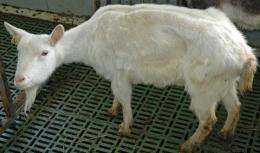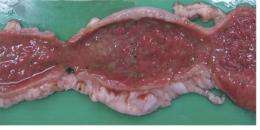New findings on the diagnosis of paratuberculosis in goats

Measuring immune responses with the help of a so-called interferon gamma test can help to diagnose paratuberculosis in goats.
However, infection in goats was discovered later than expected when this test was used and a positive test result can be inhibited by other immune responses in the animals, reveals a PhD project carried out at the Norwegian Veterinary Institute.
Paratuberculosis is a chronic inflammation of the intestines occurring in ruminants and caused by the bacterium Mycobacterium avium subspecies paratuberculosis (MAP). This disease can lead to significant production losses and negatively affect animal welfare.
Interferon gamma (IFN-γ) is a neurotransmitter in the immune system which it is believed plays an important role in protecting the body from MAP. It is difficult to diagnose the disease at an early stage, but a test that measures IFN-γ production in the blood is considered to have the greatest potential for diagnosing paratuberculosis at an early stage of the disease. An IFN-γ response is normally expected to occur before an antibody response, whereas an antibody response is more dominant than IFN-γ production in the advanced stages of the disease.

Kari Røste Lybeck has studied goats naturally infected by the paratuberculosis bacterium and results from her research show that the IFN-γ test can be a useful tool for diagnosing this disease in goats in Norway. However, the goats showed a positive reaction to this test at a later stage than expected. Other ways of diagnosing the disease, such as the detection of antibodies in the blood or bacteria in faeces, were able to detect the disease at an equally early stage in some cases.
Contrary to expectations, the results of Lybeck’s doctoral research demonstrated that the IFN-γ response remained high, even in animals suffering from advanced stages of the disease, when they were secreting large concentrations of paratuberculosis bacteria in their faeces and showing serious symptom changes. It was therefore not easy to prove that the IFN-γ had the anticipated protective effect.
Lybeck’s research also showed that another neurotransmitter, interleukin-10 (IL-10), could limit the production of IFN-γ. Inhibiting IL-10 increased the sensitivity of the IFN-γ test, but simultaneously lowered its rate of accuracy. Many of the infected goats had serious changes in symptoms and also a higher than normal level of IL-10, both in their blood and their damaged bowel tissue. It is possible that the IL-10 production may have made the infection worse, but it could also be that the IL-10 was merely the consequence of an extensive inflammatory process.
To sum up, this study provides useful knowledge about the development of immune responses to a paratuberculosis infection and about the diagnosis of paratuberculosis in goats.
The research was financed by the Norwegian Research Council and by TINE BA and was carried out at the Norwegian Veterinary Institute from 2006-2012. The project “Healthier Goats” was a key collaborator.
DVM Kari Røste Lybeck defended her doctoral research on 6th June 2012 at the Norwegian School of Veterinary Science (NVH) with a thesis entitled:
”Mycobacterium avium subsp. paratuberculosis infection in goats - immune responses and diagnosis with emphasis on interferon gamma production”.
Provided by Norwegian School of Veterinary Science














